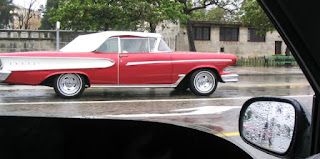Where Pontiacs fade, but never die

The Pontiac brand, the rumours say, is about to be axed as part of the survival plan for not-so-General Motors. For those of us who remember the Wide-Track models of the 1960s, the Canadian-market Beaumonts and Parisiennes and so many other fine Pontiacs, this is a sad moment. Yet we can take comfort in knowing there’s a place where ’48 Torpedo Deluxes and ’54 Star Chiefs and ’58 Chieftains will roll on, just like the De Sotos, Edsels and yes, Oldsmobiles that became orphans of commerce. In Cuba, Pontiacs will live forever. (image from plan59.com )





